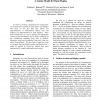Free Online Productivity Tools
i2Speak
i2Symbol
i2OCR
iTex2Img
iWeb2Print
iWeb2Shot
i2Type
iPdf2Split
iPdf2Merge
i2Bopomofo
i2Arabic
i2Style
i2Image
i2PDF
iLatex2Rtf
Sci2ools
VISUALIZATION
1994
IEEE
1994
IEEE
A Lattice Model for Data Display
We will try to address the need for a formal foundation for visualization by taking an analytic approach to defining D. Since an arbitrary function D: U V will not produce displays D(u) that effectively communicate the information content of data objects u U, we seek to define conditions on D to ensure that it does. For example, we may require that D be injective (i.e., one-to-one), so that no two data objects have the same display. However, this is clearly not enough. If we let U and V both be the set of images of 512 by 512 pixels with 24 bits of color per pixel, then any permutation of U can be interpreted as an injective function D from U to V. But an arbitrary permutation of images will not effectively communicate information. Thus we need to define stronger conditions on the function D. Our investigation depends on some complex mathematics, although we will only present the conclusions in this paper. The details are available in [7]. In order to develop a foundation for visuali...
| Added | 09 Aug 2010 |
| Updated | 09 Aug 2010 |
| Type | Conference |
| Year | 1994 |
| Where | VISUALIZATION |
| Authors | William L. Hibbard, Charles R. Dyer, Brian E. Paul |
Comments (0)

